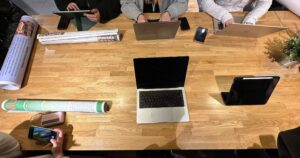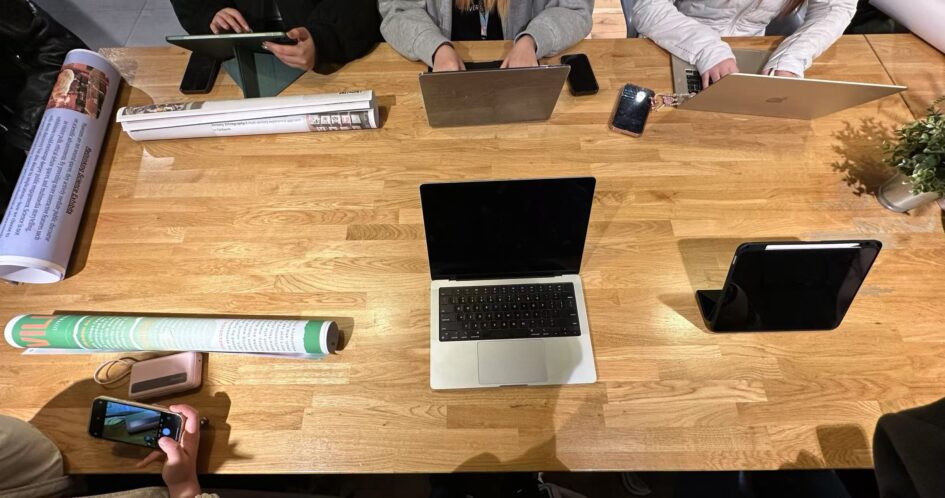This week, we decided on a theme for our artists’ collective. We held group meetings. In our meeting we identified the theme for our collective curatorial project, ‘
Here are my thoughts:
An echo is a delayed sound, a reappearance of something that has already happened, but it does not return as it was, but is distorted in its propagation and refracted by its environment. It is both a trace of the real event and a trigger for new events. I choose ‘Echo’ as the core curatorial concept.
In Echo Road, the exhibition is set up as a spatial structure composed of sounds, movements, residual shadows and traces. When the audience enters the exhibition, they are not confronted with a ‘list of works’ in the traditional sense, but a spatial system that can be ‘triggered’. Their every action – stopping, sounding, walking, touching – may be recorded by the space and returned to other viewers or their future selves as ‘echoes’. This exhibition is a mobile field constituted by behaviours, rather than a static viewing field.
We set up multiple entrances, and each viewer will enter the exhibition from different directions, entering spatial modules with non-overlapping paths: some areas emphasise the visual residue and dislocation of images, others are composed of sound feedback and the superimposition of the viewer’s voice, while others respond to the viewer’s actions with light, vibration, or voice. The viewer does not ‘see the work’ here, but ‘generates traces’ at each node.
The centre of the exhibition is not an object, but an ‘echo hub’: an interactive installation that constantly absorbs, superimposes and releases the traces of the viewer. It may play the whispered words of an hour ago, transform footsteps into streams of light, or recombine words and phrases left by the viewer through AI and project them on the wall. No one knows when and in what form the ‘echoes’ they leave behind will return, but each return becomes the starting point of a new path.
Through this spatial system, we hope to break the linear way of viewing and generate an exhibition site with openness, circularity, episodicity and a sense of collective traces. The Road of Echoes is not about the past, but about the question of ‘what to leave behind’.
After much discussion, our group’s final curatorial theme was set as: ‘Who Defines “Real”?’ Presented by Aobing Wang
This theme responds to the collective metaphor of our identity as ‘Sleepwalker’ – we are like individuals walking in our sleep in the midst of complex information landscapes and technological illusions, trying to grasp the boundaries of some kind of certainty in the midst of an indistinguishable reality. However, we are not satisfied with the passive acceptance of the ‘real’ narrative, but hope to actively ask through artistic intervention: who actually constructed the ‘reality’ we see? And why does it keep deforming in the change of visual technology?
Taking the concept of ‘reality’ as the core of the discussion, the exhibition traces the early desire for visual manipulation of mankind during the Industrial Revolution from 19th-century visual mechanical devices such as kaleidoscopes and mirrors. At the time, the mirror created the illusion of movement by looping film, and the kaleidoscope tamed the chaos of matter with geometric repetition. These devices not only demonstrated mankind’s initial attempts to create ‘moving images’, but also exposed how ‘reality’ could be shaped by technology, They also expose how the ‘real’ can be shaped, disguised, and even replaced by technology. They are prototypes of modern visual media and early metaphors for virtual technology.
Entering the digital age, our exhibition will compare the physical peephole of the Western mirror with the screen mechanism of today’s smartphones, further revealing how contemporary technological media ‘frame’ perception: today’s viewers are often forced to be passive recipients of information, understanding the world in a rhythm set by algorithms and in a field of view limited by the screen. This way of viewing is never neutral; it visually constructs a new reality and subconsciously shapes our understanding of the ‘real’.

Sleepwalker meeting
The Sleepwalker exhibition intends to introduce various art forms as catalysts for reflection in this tension of perception and manipulation – including mechanically powered installations, AI-generated imagery, and participatory interactive installations. These works will not only continue the echoes between historical and contemporary visual languages, but will also invite the viewer to reposition themselves: are we witnesses to reality, or are we complicit in illusion?



Leave a Reply